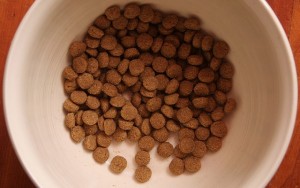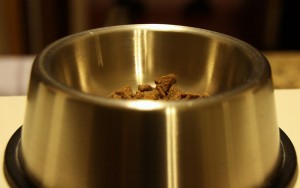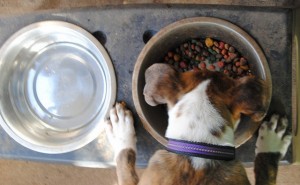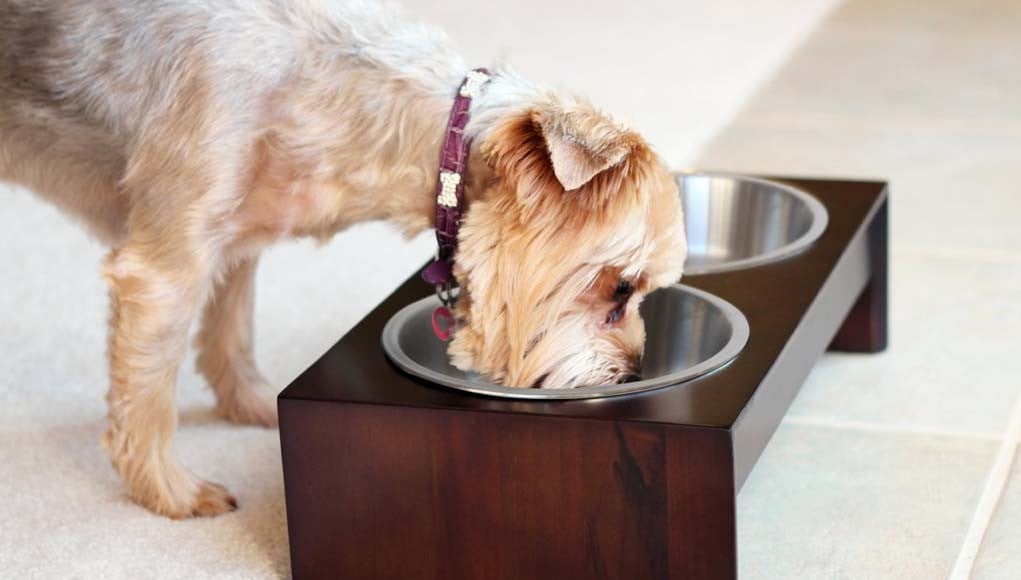Table of Contents
How many times have you asked yourself whether you should buy a raised dog bowl or a regular one for your pooch? Me too. This debate about dog bowl types has been going on for a while, and there have even been studies done on how elevated dog food bowls affect our canines.
If dogs could talk, they’d probably say that their favorite time of the day is either mealtime or playtime. Indeed, it's unlikely that there's any living creature on this Earth happier than a dog chowing down her kibble after a long day. However, the quality mealtime of your pooch isn't only about the nutrition or specific dog food brands; it's also about where your pet eats her kibble from.
The different designs of dog food bowls matter somewhat (as far as we are currently aware based on evidence) when it comes to making sure that your pet is healthy and happy, and the debate of regular dog food bowls versus elevated dog bowls, also known as dog raised bowls, has been around for a while. Today, we'll dig deeper into this subject to see which bowls are better for our dogs and why.
RELATED: Ten Best and Cheapest Dog Foods
A regular dog bowl is the one that lies flat on the floor. There is no elevation under it; the bottom is firmly planted directly on the ground. A raised food bowl is anything that takes the bottom of that bowl and lifts it up anywhere from a few inches to more than a foot. The height of the elevation depends on the height of the dog.

But height – while a major factor – isn't the only thing you should consider when choosing what type of dog bowl to buy for your pooch, even if you go after a raised feeder for pets. You should also think about the following:

- What material would you like it made out of? The most popular materials for dog bowls are steel, plastic, and ceramic.
- What will best match the décor of your home?
- What is your budget? Believe it or not, certain pet bowls and automatic feeders can run upwards of $100!
- Will you be taking these bowls with you whenever you travel somewhere with your pup?
What seems like a minor difference between these two dog food bowl designs is actually one that should be considered very carefully when you're deciding on the most optimal way to feed your Fido. There are pros and cons to both raised and regular food bowls that should be taken into consideration before purchasing either one.
TRY THIS: The 5 Best Raised Dog Food Bowls
Regular Dog Bowls vs. Raised Dog Bowls
Pros of Dog Regular Food Bowls

1 The cheapest option available. Oftentimes, regular food bowls for pets are less expensive than raised dog bowls. Between the food, bedding, toys, and vet bills, a dog can be pretty costly, but food bowls that have no elevation to them are sold cheaply anywhere — they’re not pet-store-exclusive.
As I've just mentioned, dog bowls can be made from many different materials, and the price will depend on which material you choose.
2 Less of a chance for canine bloat. Pet owners who use regular bowls are less likely to experience a bowl-related risk of canine bloat in their pooch, which is a condition where the dog’s stomach fills up with gas and air. It's been anecdotally observed that dog-elevated bowls are more likely to cause this condition, but more proof is required to draw a definite conclusion on this one.
Canine bloat disorder itself is especially dangerous because it can lead to gastric dilatation-volvulus (GDV), a disease where the stomach twists in on itself, pinching off the blood flow and causing severe damage. It is a life-threatening condition that requires urgent veterinary care.
RELATED: How to live with dogs when on a budget
In 2000, Purdue University studied this disease [1] and found that 50% of dogs who used elevated food dishes had contracted gastric dilatation volvulus. However, it is important to note that that study does NOT necessarily determine causality, only correlation, so the results could be interpreted in several ways. It is believed that since the dog doesn't have to bend over to reach for the food, she is able to gulp it down faster, thus causing digestive issues.
3 Can be easily found anywhere. Finally, regular food bowls for dogs are more commonly used and are very frequently the first choice of feeder by many dog owners because not only are they cheaper, but they are also available pretty much everywhere.
These types of bowls are very portable, too — there’s no disengaging and maneuvering to get the food bowl out of the holder and into the sink. You can just pick it up, wash it, and set it back down.
Cons of Regular Food Bowls
1 Possible health issues. One of the most important downsides to note about regular food bowls for pets is that there are several conditions associated with eating from them. Much in the same way that the Purdue study noted a correlation between GDV and elevated food bowls, regular food bowls have their own reputation to worry about, too.
A regular food dog bowl doesn’t always ensure the smooth passage of food from the throat to the stomach, which can exacerbate the problems in a dog that already has esophageal or digestive difficulties.
2 Might be uncomfortable for the dog. Another negative consequence of using a regular food bowl is that the dog has to eat in an awkward position.

Since the bowl is pressed against the ground, larger breed dogs have to bend way over to eat. Even though this probably won't cause arthritis in your dog, your Fido's back, neck, shoulders, and other joints associated with the motion are still affected.
Day after day, stressing those parts of the body might eventually take its toll on your pooch's body.
3 Some regular bowls are messy. Finally, certain types of regular dog food bowls can ensure a messier place after your dog is done eating. This is because those bowls slide all over the place when your pooch is trying to scrub up the last bits of that tasty meal, causing food to be scattered around the area.
Unlike cats, dogs are messy eaters, and having food that close in proximity to the ground means that your floor might be in for a splatter-fest.
Pros of Elevated Food Bowls
In a debate about regular dog bowls vs raised dog bowls, there are some underlying health benefits of elevated options that may not be so easy to see in the first place.
1 Great for large breeds. It's obvious why elevated food bowls are good for large-breed dogs. Vets recommend these types of feeders for dogs, such as Great Danes or Mastiffs, because it elevates the food to their level, helping them to eat more comfortably. There’s a lot of strain on a dog the size of a Mastiff (which can grow up to 32 inches tall!) to bend to reach a bowl way down on the ground.
All that bending down can end up putting a lot of wear and tear on the dog’s shoulders and neck. If she already has preexisting arthritis, an elevated food bowl may be easier for her. An older dog won't have to bend down to eat, which is a relief for a pooch experiencing early stages of arthritic pain, and it might even help prevent arthritis from setting in in younger dogs as well.
However, even small dog breeds can benefit greatly from elevation until it's shown that raised bowls might actually cause issues with a dog's digestive system. It simply seems more comfortable for a pooch of any size to be eating from an elevated level. For example, one of the more popular elevated dog bowls from PetFusion pictured in the featured image and on the right has been praised by many dog owners for the fact that their pets love it. More importantly, I haven't seen a single Amazon review saying that a raised bowl has caused any health issues for the dog. Go figure.
Again, all of this is anecdotal, so either take it or leave it, and whichever dog product you go for – always do your research.
2 Helps to avoid megaesophagus. Megaesophagus is a condition where the tube that leads from the mouth to the stomach becomes flaccid and engorged, weakening the muscular contractions and inhibiting a canine’s ability to swallow. This can lead to vomiting or choking.
By elevating the food bowl, a dog is given gravitational assistance that allows the esophageal muscles to have an easier time getting the food down to the stomach.
3 Helps to keep everything neat. Because elevated dog bowls are fixated on a stand, they are not sliding across the floor when the dog eats, splattering food all over the place. It stays in one location, and so does the food, which is a blessing for owners weary of cleaning up after their messy dogs.
Likewise, many elevated bowls provide a tray or dog food mat of some sort that will catch all food and water that is dropped by the dog. These have always been very useful with my pooch and his food bowl in the kitchen to avoid any mess or to clean it up easily later. If your pooch has a flat face, like my girls, or large jowls that cause water and food to run out all over the floor, an elevated bowl with a tray to catch drips and spills is an excellent choice.
Cons of Elevated Food Bowls
1 A pricier option. Unfortunately, raised dog food bowls are more expensive. Because they come with a stand and are much sturdier than regular dog bowls, you're going to pay more.
Although it's likely you won’t break the bank buying one, the cost of owning a dog do add up and this is simply yet another extra expense that you should consider ahead of time before adopting a pooch.
2 Potential link to canine bloat. As I have already mentioned in the “pros” section when discussing regular food bowls in this article, a Purdue University study found that half of dogs who ate from elevated food bowls also had GDV, a deadly gastrointestinal condition that morphs from bloat. How strong the causality is between elevated feeding and bloat is uncertain, but the study is something to be aware of.
The reason the above can happen is because when eating from an elevated feeder, a dog is able to suck in more air during the consumption of food, which can get trapped in the stomach. That's a problem that many pet owners face today with their canines.

3 Elevated food bowls are unwieldy. Though some have stands that fold up and are easy to carry, these raised food bowls can take up more space than the regular ones because of the additional parts. For dog owners with small kitchens or apartments, this could be problematic.
You will also have somewhat more “problems” if you're planning to move that dog-raised bowl very often (possibly from one room to another). It is simply less convenient for pet owners who always have a reason to move their canine's bowl.
So which one, raised or regular?
Based on what we currently know about these two types of dog food bowls, there's no clear answer. Both regular and elevated options have their pros and cons, and further research is still required in terms of what potential health problems might be caused or prevented by using either one. At this point, it all comes down to your dog's breed, preference, health situation, your own home situation, and many other personal factors.
While both regular and elevated food bowls have their pros and cons, whether or not you decide to use them is dependent on what type of dog you have and the needs that particular dog has. Researching and evaluating these health requirements and risks is very important for any owner to do before purchasing a food bowl for the pet.
Some sites with excellent information about choosing the right dog bowl for your pet are:
There hasn't been much scientific research done on the issue of regular dog bowls vs raised dog bowls, so make sure the information you are receiving is from a trusted source. If you receive advice on using one type or the other, remember to cross-reference their claims with any valid data you can find online.
Much of the information available online today is based on educated guesses, speculations, and personal biases.
References and further reading:
- Diet-related risk factors for gastric dilatation-volvulus in dogs of high-risk breeds: A nested case-control study.
- 2014 NJ State 4-H Dog Bowl Study Guide (PDF)
- Management of a congenitally shortened soft palate in a dog.
Featured image courtesy of PetFusion, originally published on their Amazon product page.
Disclosure: We may earn affiliate commissions at no cost to you from the links on this page. This did not affect our assessment of products. Read more here and find full disclosure here.




![PetFusion Large WATERPROOF Pet Food Mat (24x16). FDA Grade Silicone [superior hygiene, non-toxic, multiple sizes] For dogs or cats, Gray PetFusion Large WATERPROOF Pet Food Mat (24x16). FDA Grade Silicone [superior hygiene, non-toxic, multiple sizes] For dogs or cats, Gray](https://m.media-amazon.com/images/I/41Gnn64qh4L._SL500_.jpg)










